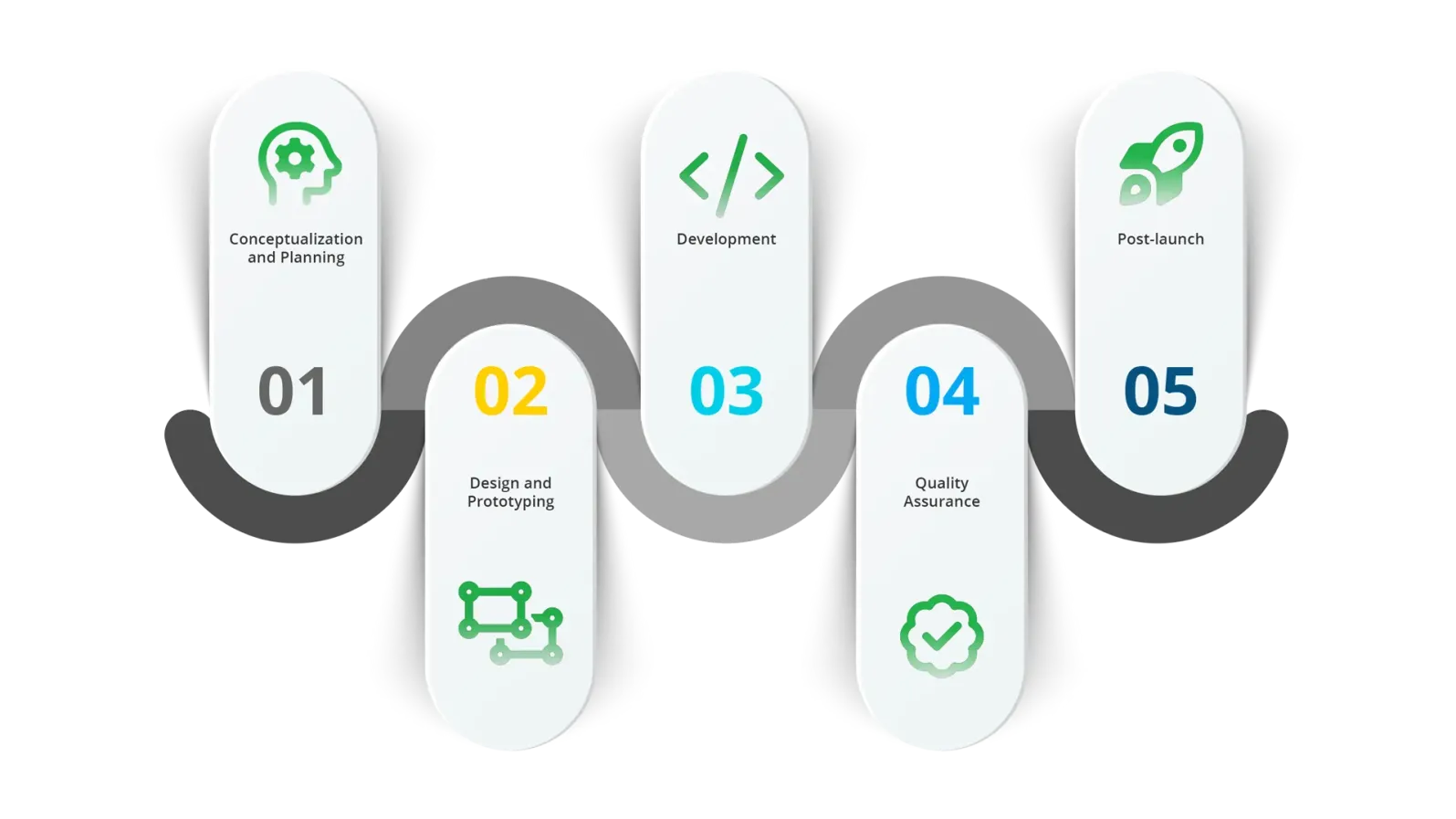The fitness app industry of late has experienced an unprecedented boom, driven by the convergence of technological advancements and a growing global emphasis on health and wellness. With smartphones becoming an integral part of our daily lives, fitness apps have emerged as essential companions for individuals seeking personalized and convenient solutions to achieve their health goals. This surge in demand has transformed the fitness app landscape, making it one of the most dynamic and competitive sectors in the broader app development market.
The increasing prevalence of sedentary lifestyles, coupled with rising health consciousness, has elevated the role of fitness apps in promoting and maintaining overall well-being. Beyond serving as mere tools for tracking steps or calories, these apps have evolved into comprehensive platforms offering tailored workout routines, nutritional guidance, and real-time health monitoring. In essence, fitness apps have become catalysts for a healthier lifestyle, empowering users to take charge of their physical well-being in a digitally connected world.
As the demand for such apps continues to soar, it becomes imperative for businesses, entrepreneurs, and developers to grasp the nuances of the financial landscape associated with bringing a fitness app to life. By comprehensively exploring the various factors that contribute to the overall cost, this blog aims to provide valuable insights and guidance for those navigating the intricacies of developing a successful fitness application.
The Growing Demand for Fitness Apps
According to recent market analyses, the global fitness app market is on a trajectory of remarkable growth, with projections indicating a valuation exceeding USD 21.06 billion in 2030. This robust expansion is fueled by a compound annual growth rate (CAGR) of 17.30%. These figures underscore the increasing reliance on digital solutions for health and fitness management, signifying a paradigm shift in consumer behavior.
The escalating awareness of health-related issues and the desire for active lifestyles have amplified the demand for fitness apps. Individuals are now more conscious of the importance of regular exercise and proper nutrition, seeking accessible and user-friendly solutions to integrate fitness seamlessly into their routines. Fitness apps act as virtual wellness companions, providing guidance, motivation, and measurable results, aligning perfectly with the contemporary emphasis on preventive healthcare.
User Preferences and Trends in Fitness App Usage
Understanding user preferences is pivotal in deciphering the trajectory of the fitness app industry. Beyond basic functionality, users now gravitate towards apps that offer a holistic experience. This includes personalized workout plans, social interaction features, and integration with wearables for comprehensive health monitoring. Additionally, the rise of virtual fitness classes and on-demand workouts has reshaped how users engage with fitness apps, pointing towards a more dynamic and immersive future.
Key Features and Functionalities
Fitness apps have different features and perform different functionalities. Some of the key characteristics of a fitness app are discussed below:
1) Popular Features in Fitness App
Fitness apps have evolved beyond simple step counters. Contemporary users demand a rich array of features, including but not limited to:
- Workout Tracking: Real-time monitoring of exercise routines.
- Nutritional Guidance: Integration with databases for tracking food intake.
- Social Connectivity: Platforms for sharing achievements and connecting with like-minded individuals.
- Goal Setting: Customizable goals based on individual fitness levels and aspirations.
2) Customization Options and User Engagement Features
Customization is a key driver of user engagement. Successful fitness apps allow users to tailor their experiences and personalize their routine, such as:
- Personalized Workouts: Adaptive routines catering to individual fitness levels.
- Progress Tracking: Visual representations of achievements and improvements.
- Notification Preferences: Customizable alerts for workouts, goals, and achievements.
3) Integration with Wearables and Other Devices
The integration of fitness apps with wearables, smartwatches, and other health monitoring devices has become commonplace and a trend these days. This seamless integration facilitates the user in myriad ways and enables:
- Real-time Health Monitoring: Continuous tracking of heart rate, sleep patterns, and more.
- Data Synchronization: Automatic transfer of fitness data between the app and wearables.
- Enhanced User Experience: A comprehensive approach to health and fitness management.
While these features are highly efficacious and enhance the user experience, they also contribute to the overall development costs. The more intricate and interactive the features, the higher the development expenditure. Striking a balance between functionality and cost efficiency is crucial for the success of a fitness app.
Factors Influencing Fitness App Development Costs
There are a number of factors that play a role in determining the cost of a fitness app. some of the key factors include the following:
Platform (iOS, Android, or Cross-Platform)
The choice of platform significantly influences development costs as developing for iOS, Android, or both requires distinct sets of considerations. Native development for each platform tends to be costlier, while cross-platform development offers a more budget-friendly but potentially less optimized solution. The choice of the platform mainly depends on your needs and preferences and of course on your budget. Commonly, it has been observed that the costlier, the more efficacious.
Design Complexity and User Interface Considerations
Design plays a key role in the success of a fitness app. A visually appealing and intuitive user interface is highly imperative for user engagement. However, intricate designs and high levels of interactivity contribute to higher design costs. Striking the right balance is essential for cost-effective yet aesthetically pleasing design. It must be kept in mind that cost-effectiveness must not come at the cost of intricacy and high interactivity.
Development Team Expertise and Location
The expertise of the development team is directly proportional to the quality of the product. A highly skilled team may demand higher initial costs but can result in a more robust and efficient app. Additionally, the geographical location of the development team impacts costs, with rates varying significantly between regions. It is good practice to do thorough market research in this regard to go with the option that suits your needs.
Third-Party Integrations and API Usage
The integration of third-party services and APIs can significantly enhance the functionality of a fitness app but also adds to the development costs. Services such as payment gateways, fitness device synchronization, and social media sharing contribute to both time and budget considerations. However, strategic integration is often essential for providing a seamless user experience.
Security and Compliance Considerations
Ensuring the security of user data and compliance with industry regulations are non-negotiable aspects of fitness app development. Implementing robust security measures adds an additional layer of complexity and cost but is indispensable for maintaining user trust and adhering to legal standards. Prioritizing security is an investment in the long-term success and credibility of the app.
Development Process and Cost Estimation
Embarking on the development journey of a fitness app entails a meticulous process, where costs depend on many factors across diverse regions. Let’s start with the understanding of the development process first:

Conceptualization and Planning:
In the initial stages, collaborative efforts are focused on conceptualization and planning, involving the definition of app features, functionalities, and a comprehensive market analysis. This includes delving into competitor fitness apps, scrutinizing market trends, and garnering insights to refine the app’s positioning and features in alignment with user expectations.
Design and Prototyping:
The subsequent phase delves into the design and prototyping realm. User Interface (UI) and User Experience (UX) designs are meticulously crafted to ensure a seamless and engaging interface. Wireframes and prototypes are developed iteratively, with constant refinement based on user feedback and testing.
Development:
The development phase comprises front-end and back-end development, translating the designed interface into a functional application. This involves the implementation of user interface designs and the creation of logic for data processing and user interactions. Integration with fitness tracking APIs ensures a cohesive connection with health tracking devices.
Quality Assurance:
Quality Assurance (QA) testing follows, engaging in rigorous scrutiny to identify and rectify bugs or glitches. The app undergoes testing across various devices to guarantee smooth functionality, with user acceptance testing validating the overall user experience.
Upon completion, deployment initiates with the launch of the app on relevant platforms (iOS, Android). Strategies for App Store Optimization (ASO) are implemented to enhance visibility, and analytics tools are set up for continuous monitoring of user engagement.
Post-launch:
Post-launch activities encompass establishing a feedback loop for user comments and issues, regular updates to introduce new features and improvements, and vigilant monitoring of performance metrics to address emerging challenges.
When it comes to the cost estimation, there is no definitive answer as it depends on the complexity of the app. However, on average, the development cost of a fitness app may range from $30, 000 to $250,000 or more. Various factors play a role in deciding the overall cost and geographical location is one of them.
Cost varies across regions, with North America featuring higher costs while Africa showcases relatively cost-effective development. The determinants that contribute to the cost estimation also vary. The table below shows a glimpse of it:
Strategies For Optimizing Fitness App Development Costs
The development cost is certainly a factor that would worry everyone embarking on the journey of developing a fitness app. here are some useful tips to optimize your cost:
- Prioritizing Essential Features: Identify and prioritize essential features to allocate resources efficiently.
- Agile Development Methodologies: Adopt agile development for flexibility and iterative improvements.
- Choosing the Right Development Team: Invest in a skilled team for a more robust and efficient app.
- Long-term Cost Considerations and Scalability: Factor in long-term costs and design for scalability to prevent unforeseen expenses.
Conclusion
To cut a long story short, understanding the costs estimation of fitness app development is crucial for informed decision-making. The global cost breakdown, coupled with real-world examples and lessons learned, provides insights for navigating this dynamic industry. By optimizing costs, prioritizing features, and considering long-term implications, businesses and developers can embark on the journey of creating successful fitness apps that stand out in the competitive market. As the fitness app landscape continues to evolve, strategic planning and financial foresight will play key roles in shaping the industry’s future.
A healthy lifestyle is paramount like nothing else and keeping fit requires proper checks and balances. To this end, a robust and full-functioning fitness app can help you a great deal in living up to your fitness aspirations. Oak Street Technologies takes immense pride in helping you with what you aspire for in the best possible way. Behind our innovative app development services, there is a team of expert developers who are known for bringing ideas to life through coding. We are a message away!



